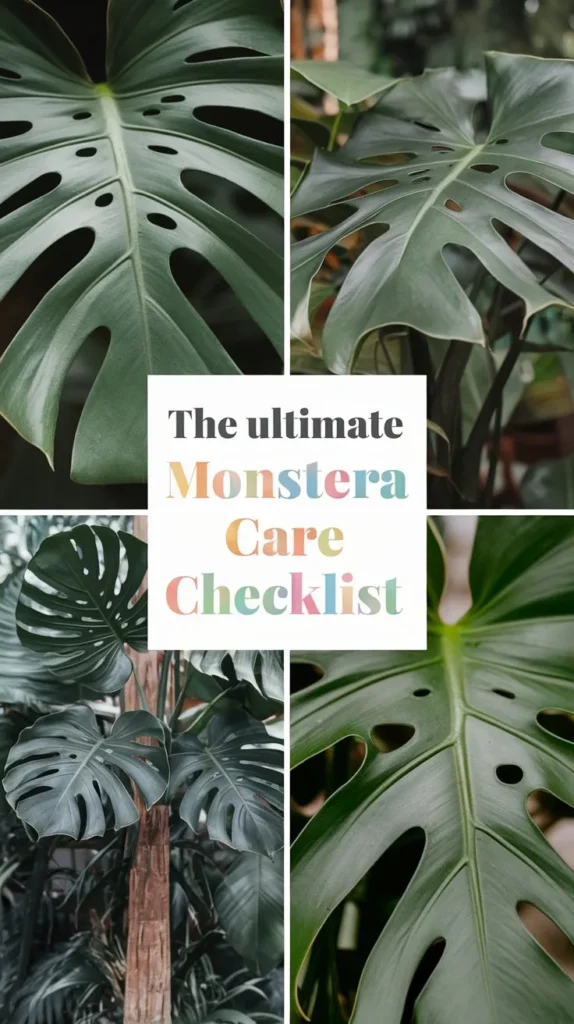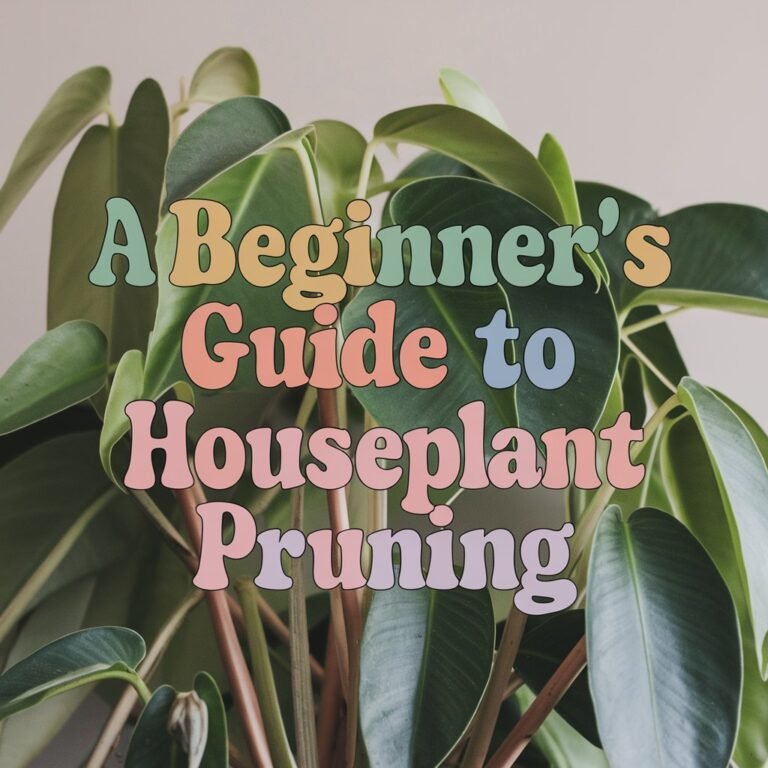The Ultimate Monstera Care Guide: Lighting, Watering, and More for Thriving Plants
As you bring a Monstera houseplant into your home, you’re likely enthusiastic to provide it with the best care possible. You’ve probably already noticed its unique, glossy leaves and are excited tosee it thrive. But, you might be wondering what specific conditions it needs to reach its full potential.
You’re not alone – many Monsteras struggle to adapt to indoor environments, leading to weak growth and pest issues. By following the right guidelines, you can create a tropical oasis that will make your plant flourish. So, what are the secrets to revealing your Monstera’s full beauty?
In a Nutshell

- Provide bright, indirect light, avoiding direct sunlight, and maintain 50-70% humidity for optimal growth and development.
- Water consistently, checking soil moisture, and avoid getting water on leaves or the crown to prevent damage and rot.
- Fertilize with a balanced, phosphorus-rich fertilizer during the growing season, and prune to control size and promote healthy growth.
- Use a well-draining potting mix with a slightly acidic to neutral pH, and repot in the spring and summer as needed.
- Monitor for pests like fungus gnats and spider mites, and propagate using air layering or stem cuttings to expand your indoor jungle.
Understanding Monstera Lighting Needs
Since Monsteras are native to tropical regions, they’re adapted to thrive in bright, indirect light.
As a houseplant owner, you’ll want to replicate this environment in your home. East-facing windows are ideal, as they provide gentle, indirect light that won’t scorch your Monstera’s leaves.
Avoid placing your plant in direct sunlight, especially during peak hours, as this can cause damage.
In bright spaces, your Monstera will photosynthesize efficiently, promoting healthy growth and development.
However, if your room lacks natural light, don’t worry. Monsteras can tolerate low light conditions, but growth may be slower.
Consider using grow lights to supplement the natural light, especially during the winter months when daylight hours are shorter.
When positioning your Monstera, keep in mind that it prefers light that’s filtered through a sheer curtain or shade.
This will certify your plant receives the right amount of light without being overwhelmed.
Watering Your Monstera Correctly
With its tropical roots, your Monstera has evolved to thrive in a humid environment, which means it needs consistent moisture to stay healthy.
To achieve this, you’ll need to establish a reliable watering schedule. Check the soil moisture by sticking your finger into the soil up to the first knuckle. If the soil feels dry, it’s time to water. Aim to water your Monstera when the top 1-2 inches of soil feel dry.
Watering schedules can vary depending on factors like pot size, soil mix, and climate.
As a general rule, water your Monstera every 1-2 weeks during the spring and summer months when it’s actively growing. During the fall and winter, you can reduce watering to every 3-4 weeks.
When you do water, make sure to water thoroughly. Water should flow out of the drainage holes, indicating that the soil is fully saturated.
Avoid getting water on the leaves or crown to prevent rot. By sticking to a consistent watering schedule and monitoring soil moisture, you’ll be able to provide your Monstera with the right amount of moisture to thrive.
Humidity and Temperature Control
During the peak growing season, your Monstera’s humidity requirements become even more critical.
Monsteras thrive in environments with high humidity, typically between 50-70%. To maintain ideal humidity levels, consider investing in humidifier options, such as ultrasonic or evaporative humidifiers. These devices can increase the moisture in the air, providing your Monstera with the humid environment it needs.
Temperature fluctuations can also impact your Monstera’s health.
Ideally, keep your Monstera in an area with a consistent temperature between 65-75°F (18-24°C). Avoid placing your plant near heating or cooling vents, fireplaces, or drafty windows, as these can cause temperature fluctuations.
If you live in an area with extreme temperature fluctuations, consider using a temperature-controlled greenhouse or a room with a stable temperature.
Fertilizing for Healthy Growth
By providing your Monstera with ideal humidity and temperature conditions, you’ve set the stage for healthy growth.
Now, it’s time to focus on fertilizing for peak development.
When it comes to feeding your Monstera, you’ll want to provide a balanced fertilizer that’s high in phosphorus to promote healthy root growth and fruiting.
A water-soluble fertilizer applied during the growing season (spring and summer) will give your plant the necessary nutrients for vigorous growth. Dilute the fertilizer to half the recommended strength to avoid burning your plant’s roots.
In addition to soil fertilization, consider foliar feeding to address potential nutrient deficiencies.
This involves spraying a micronutrient-rich solution on the leaves to provide a quick absorption of essential micronutrients.
Be aware that over-fertilization can lead to nutrient deficiencies, so monitor your plant’s response and adjust accordingly.
Pruning and Training Techniques
Take your Monstera’s growth to the next level by pruning and training it to optimize its unique, vining habit.
Pruning is essential to control the plant’s size, promote healthy growth, and encourage leaf shaping. Remove any dead or damaged leaves or stems to prevent the spread of disease and encourage new growth.
Cut back long stems to encourage branching, and trim away any leggy vines to maintain a fuller appearance.
Training your Monstera involves guiding its stems to twine around a trellis or other support. This helps to keep the plant upright, promotes stem twining, and adds visual interest to your space.
Use soft ties or twine to gently secure the stems to the support, taking care not to constrict the plant. As your Monstera grows, it will naturally twine around the support, creating a beautiful, lush display.
Regular pruning and training will help you achieve a stunning, thriving Monstera that adds a touch of tropical elegance to your home.
Soil Requirements and Repotting
What kind of soil will provide the best environment for your Monstera’s roots to thrive?
Monsteras prefer well-draining potting mixtures with a slightly acidic to neutral soil pH, ranging from 6.0 to 7.0. You can achieve this by combining peat moss, perlite, and vermiculite in a ratio of 2:1:1.
Avoid using regular garden soil, as it can compact and prevent proper drainage.
When repotting, choose a pot that’s only one to two sizes larger than the current one to prevent the soil from becoming too wet.
Spring and summer are the best seasons for repotting, as your Monstera is actively growing. Gently remove the plant from its pot, taking care not to damage the roots.
Trim away any dead or damaged roots, and then place the plant in its new pot, adding fresh potting mixture around the roots.
Water thoroughly after repotting, and monitor your plant’s condition closely.
Common Pests and Diseases
With proper care, your Monstera houseplant can thrive, but it’s not immune to common pests and diseases that can quickly spread and cause significant damage.
One of the most common pests you’ll encounter is fungus gnats, tiny flying insects that lay their eggs in moist soil.
The larvae feed on fungi and algae, but can also damage your plant’s roots. Check for fungus gnats by placing a sticky trap near the soil or looking for tiny flying insects around your plant.
Another pest to watch out for is spider mites, tiny arachnids that feed on your plant’s sap.
They’re usually found on the underside of leaves and can cause yellowing or bronzing of the foliage. Inspect your plant regularly for signs of spider mites, such as fine webbing or tiny moving dots.
Regularly inspecting your plant, maintaining good air circulation, and avoiding overwatering can help prevent pest and disease issues.
If you do notice a problem, isolate your plant, prune affected areas, and treat with insecticidal soap or neem oil according to the product’s instructions.
Propagation and Division Methods
Beyond its striking appearance, one of the most appealing aspects of Monstera houseplants is their ease of propagation, allowing you to share plants with friends or expand your indoor jungle.
You can propagate your Monstera using various methods, including Air Layering and Stem Cuttings.
Air Layering is a popular method that involves wounding the stem and encouraging roots to grow before cutting the stem below the roots.
This method reduces transplant shock and increases the chances of successful propagation.
When taking Stem Cuttings, make sure to choose healthy stems with at least two nodes.
Cut the stem just below a node, remove lower leaves, and plant it in a well-draining potting mix.
Keep the soil consistently moist and warm until roots develop.
Some key considerations when propagating your Monstera include:
- Using clean and sharp tools to prevent spreading diseases
- Providing high humidity and warm temperatures to promote root growth
- Avoiding overwatering, which can lead to root rot
- Pruning lower leaves to prevent them from rotting and causing infection
- Being patient, as propagation can take several weeks to months
Tips for Seasonal Care Changes
As you adjust your care routine to accommodate the changing seasons, remember that Monsteras have unique needs during different times of the year.
During winter, your Monstera will enter a state of dormancy, requiring less water and nutrients. Reduce watering to once every 4-6 weeks, and suspend fertilization until spring. This period of Winter dormancy allows your plant to conserve energy and prepare for new growth.
As the days grow longer and temperatures rise in spring, your Monstera will experience a Spring revival.
You can gradually increase watering and fertilization to support the plant’s renewed growth. Prune any dead or damaged leaves to encourage healthy development and promote new shoots.
This is also an excellent time to repot your Monstera, providing it with fresh, well-draining soil and a larger pot if necessary.
Frequently Asked Questions
Can I Grow Monstera in a Hanging Basket or Container?
You can create a stunning hanging beauty by growing Monstera in a basket, but be aware of basket constraints, ensuring it’s large enough to accommodate the plant’s aerial roots and providing sufficient support for its weight.
Will Monstera Plants Grow Well in a Bathroom With Low Light?
You’ll thrive in a bathroom with low light, as Monstera plants adapt to dim conditions, but guarantee the bathroom ambiance is humid, with consistent moisture levels above 50%, to create an ideal environment for your plant to flourish.
Can I Use Coffee Grounds as Fertilizer for My Monstera?
You can use coffee grounds as fertilizer for your Monstera, but be cautious: while coffee benefits include increased nitrogen and micronutrient supply, grounds’ acidity may harm your plant if not balanced with neutralizing agents or mixed with other compost materials.
How Often Should I Wipe Down the Leaves of My Monstera Plant?
You should wipe down your Monstera’s leaves every 2-4 weeks to prevent dust accumulation, which can hinder photosynthesis. Gently wipe each leaf with a damp cloth, removing dirt and debris, to maintain ideal leaf cleaning and promote healthy growth.
Is Monstera Safe for Pets and Young Children to Be Around?
You’re wise to wonder if your Monstera’s safe around pets and kids; the plant’s toxic compounds can cause oral and gastrointestinal irritation in curious critters and little ones, so keep an eye on them and your plant’s boundaries.
Conclusion
You’ve now mastered the art of caring for your Monstera houseplant. By providing the right light, water, humidity, and temperature, you’ll create an ideal environment for your plant to thrive. Regular fertilization, pruning, and training will promote healthy growth, while proper soil and repotting will support development. Stay vigilant for pests and diseases, and use propagation techniques to expand your indoor jungle. With these tips, you’ll be well on your way to enjoying a lush, thriving Monstera for years to come.












Caleb Maxwell is a seasoned horticulturist and advocate for sustainable gardening at PlantGrowthStages.com. Through insightful articles, he empowers gardeners with practical tips and eco-friendly practices. Explore the transformative journey of gardening with Caleb at PlantGrowthStages.com.







